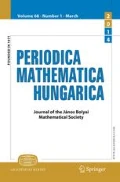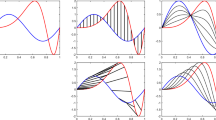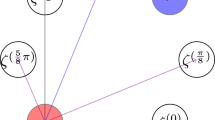Abstract
We prove that the largest convex shape that can be placed inside a given convex shape \(Q \subset \mathbb {R}^{d}\) in any desired orientation is the largest inscribed ball of Q. The statement is true both when “largest” means “largest volume” and when it means “largest surface area”. The ball is the unique solution, except when maximizing the perimeter in the two-dimensional case.
Similar content being viewed by others
References
S. W. Bae, S. Cabello, O. Cheong, Y. Choi, F. Stehn, S. D. Yoon. The reverse kakeya problem. In 34th International Symposium on Computational Geometry (SoCG 2018), volume 99 of Leibniz International Proceedings in Informatics (LIPIcs) eds. by B. Speckmann and C.D. Tóth (2018). pp. 6:1–6:13
A.S. Besicovitch, Sur Deux Questions de l’intégrabilité (Journal de la Société des Math. et de Phys, II, 1920)
A.S. Besicovitch, On Kakeya’s problem and a similar one. Math. Z. 27, 312–320 (1928)
J. Bourgain, Harmonic analysis and combinatorics: how much may they contribute to each other?. In Mathematics: Frontiers and Perspectives, ed. by V.I. Arnold, M. Atiyah, P. Lax, and B. Mazur. (American Math. Society, 2000), pp. 13–32
H. Busemann. Convex Surfaces. (Interscience Publishers 1958)
S. Kakeya, Some problems on maxima and minima regarding ovals. Sci. Rep. Tohoku Imp. Univ. Ser. 1 Math. Phys. Chem. 6, 71–88 (1917)
P.J. Kelly, M.L. Weiss, Geometry and Convexity: A Study in Mathematical Methods (Wiley, New York, 1979)
I. Laba, From harmonic analysis to arithmetic combinatorics. Bull. New Ser. AMS 45, 77–115 (2008)
G. Pál, Ein Minimumproblem für Ovale. Math. Ann. 83, 311–319 (1921)
R. Schneider, Convex Bodies: The Brunn-Minkowski Theory, Encyclopedia of Mathematics and Its Applications (Cambridge University Press, Cambridge, 2014)
T. Tao, From rotating needles to stability of waves: Emerging connections between combinatorics, analysis and PDE. Not. AMS 48, 297–303 (2001)
T. Wolff, Recent work connected with the Kakeya problem. In Prospects in Mathematics, ed. by H. Rossi. (American Math. Society, 1999)
Author information
Authors and Affiliations
Corresponding author
Additional information
Publisher's Note
Springer Nature remains neutral with regard to jurisdictional claims in published maps and institutional affiliations.
This work was initiated at the 21st Korean Workshop on Computational Geometry, held in Rogla, Slovenia, in June 2018. We thank all workshop participants for their helpful comments.
Rights and permissions
About this article
Cite this article
Cabello, S., Cheong, O. & Dobbins, M.G. The inverse Kakeya problem. Period Math Hung 84, 70–75 (2022). https://doi.org/10.1007/s10998-021-00392-z
Accepted:
Published:
Issue Date:
DOI: https://doi.org/10.1007/s10998-021-00392-z




